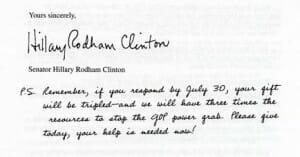If you work at a nonprofit organization, you’re probably pretty charitable yourself. Are you getting a lot of thank-you letters in the mail? Great. But have you ever received a thank-you video on your phone or computer?
You would remember if you had.
The Personal Impact of a Thank-You Video
There’s something about the face and voice of a real person saying “thanks.” Yes, I love getting thank-you letters in the mail.Video can’t substitute for an envelope with a stamp on it that you can hold in your had. But it can add.
A video can show you where your donation made a difference. That’s the approach The Nature Conservancy takes.
It can present the faces of the people who are doing the work, as charity:water did with their staff.
Or it can show you the faces of the people whose lives are better because you helped. The Children’s Hospital Foundation took that approach. They even titled their video “Thank you for supporting kids like me.”
Making Your Thank-You Video
These examples come from larger organizations, but the thank-you video is a great tool for the small nonprofit too. If you have a smart phone, you have a video camera in your pocket.
Production values are not what matter in a thank-you video. Here’s what does (according to Raymund Flandez, writing in the Chronicle of Philanthropy):
- Be brief. Don’t send out a fifteen-minute description of everything you do. One minute of gratitude says it much better.
- Say thanks–and say why. Let the donor know the impact his or her gift has made.
- Speak personally. Make sure the donor can tell who it is that’s saying thank-you and why they care.
Sharing Your Thank-You Video
Once you’ve made your thank-you video, you have multiple ways to share it.
You can email it to the donor–but sending it as an attachment may make recipients worry about being spammed. Your video is more likely to be seen if you’re using an email service like MailChimp that allows you to embed the video in your message.
You can distribute the thank-you video through your Facebook page or other social media. You can post it permanently on your website or YouTube page, so you have the link to share in the future.
And you can personalize it. With a very little bit of editing skill, you can add the individual donor’s name to the basic video and thank him or her directly. Try personalizing some of your thank-you videos and see how that affects your donor renewal!
You should plan to thank your donors throughout the year. But how? Every Thursday, I’ll share a different idea. (The first one was Give Your Donor a Voice.)

